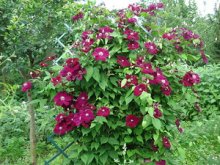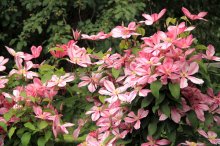Clemati In The Landscape Design Of The Garden Of Photos
 Vertical greening has always been used actively in the decoration of the suburbs. It's very good for this clammatis or lamonos. His bright, fabulous flowers revive the garden and give the buildings that they have built a truly fabulous view.
Vertical greening has always been used actively in the decoration of the suburbs. It's very good for this clammatis or lamonos. His bright, fabulous flowers revive the garden and give the buildings that they have built a truly fabulous view.
They're going to steal the roof and the back of the porch, the chat. By placing them on special scaplers, arches, pergolases, we can arrange a vice-allocation for recreation. They can successfully " shave " , " unpredictable " buildings on the day. You can say in Clamtis landscape design Not applicable.
By placing them on special scaplers, arches, pergolases, we can arrange a vice-allocation for recreation. They can successfully " shave " , " unpredictable " buildings on the day. You can say in Clamtis landscape design Not applicable.
You can't say that clamps are unsympathetic plants, but they're quite capable of growing up not even a very experienced flower breeder. These plants, depending on the species, flow throughout the season from the end of spring to the fall freezes. They are resistant to the climate of most of our regions and are not relevant to the soil (there are only wet and spring-prone flooding areas not suitable for them). Clematis are long-term residents, can grow in a garden without transplant for over 20 years.
They are resistant to the climate of most of our regions and are not relevant to the soil (there are only wet and spring-prone flooding areas not suitable for them). Clematis are long-term residents, can grow in a garden without transplant for over 20 years.
Where to land
When choosing a place to land, it must be taken into account that clammatis flower turns towards the sun, sunlight needs at least 6 hours a day. It is therefore advisable to lay them on the southern, south-west or south-east side of the site and along the walls of the structures aimed at these sides of the world. The place of landing must be warm, closed by crossroads, sunshine or half. If these conditions cannot be met accurately, in the northern areas, the native clamps of the Prince ' s plant, which are not so demanding for sunlight, unsuccessful and have a good freeze, can successfully increase the winter temperature to -30 degrees.
The place of landing must be warm, closed by crossroads, sunshine or half. If these conditions cannot be met accurately, in the northern areas, the native clamps of the Prince ' s plant, which are not so demanding for sunlight, unsuccessful and have a good freeze, can successfully increase the winter temperature to -30 degrees.
Agricultural equipment
Clatis are placed 70 cm-1 m apart. For the planting of each plant, the eggs are 60 to 70 cm long, width and depth (50 cm allowed for lung soil). The excavated land elects weeds, adds two to three buckets of compost or sand to it, adding 100 to 150 g superphosphate, 200 g of total mineral fertilizer, where possible 100 g bone flour, 150 to 200 g of beam or mela, 200 g of ash.
The excavated land elects weeds, adds two to three buckets of compost or sand to it, adding 100 to 150 g superphosphate, 200 g of total mineral fertilizer, where possible 100 g bone flour, 150 to 200 g of beam or mela, 200 g of ash.
For clammatis, regular and heavy streams are important, especially during growth. The weakness of the moisture directly affects their growth and colouring. However, the stalemate of water in the root system does not transport these plants.
Clematis are lianas, they need supports to grow, they can be special bars and spalaers, and there may be walls and various building elements, or natural supports - gardens and decorative trees.
Related posts:
 Mr. Sad, the Red-Darent Landscape Design Studio, will thank you for your individual project site. If you want to turn your garden into an artwork, your dreams can…
Mr. Sad, the Red-Darent Landscape Design Studio, will thank you for your individual project site. If you want to turn your garden into an artwork, your dreams can… The planning of a landscape design of 30 junctures is a vast area that opens up a lot of possibilities for the designer fantasy. But the advantage of a large section…
The planning of a landscape design of 30 junctures is a vast area that opens up a lot of possibilities for the designer fantasy. But the advantage of a large section… Natural stones are now very active in designing a site near the house. They are used in the form of extra jewelry, embodying a variety of fantasies. It s easy to…
Natural stones are now very active in designing a site near the house. They are used in the form of extra jewelry, embodying a variety of fantasies. It s easy to… Gabions refer to containers that are scraped from a metal wire that are filled directly at the object by a stone or a click. Construction and engineering data were…
Gabions refer to containers that are scraped from a metal wire that are filled directly at the object by a stone or a click. Construction and engineering data were… In this article, we will show you how our projects can be applied in practice. We ve got a 10-bed plot in Central Chernobyl. It s flat. There s a small single-story…
In this article, we will show you how our projects can be applied in practice. We ve got a 10-bed plot in Central Chernobyl. It s flat. There s a small single-story… It s hard to imagine a modern clumbium without such a wonderful plant as a host that affects the imagination of species and the unusual colour of leaves. There s…
It s hard to imagine a modern clumbium without such a wonderful plant as a host that affects the imagination of species and the unusual colour of leaves. There s… Before you steal the garden, think it ll be the jewels of the “temporary” or they ll stay on the precinct for a few seasons. It depends on how to steal their gardens…
Before you steal the garden, think it ll be the jewels of the “temporary” or they ll stay on the precinct for a few seasons. It depends on how to steal their gardens… The people who own plots outside the city today seek not only to build a stylish and profitable home on their land, but also to fit it as harmoniously as possible…
The people who own plots outside the city today seek not only to build a stylish and profitable home on their land, but also to fit it as harmoniously as possible… Hello, esteemed gardeners! Can anyone tell us how to form their garden and garden according to the gold cell, how to make the calculations right? If anyone has that…
Hello, esteemed gardeners! Can anyone tell us how to form their garden and garden according to the gold cell, how to make the calculations right? If anyone has that… The reader of the Greenportal Sergei Galkin was planning to build a watermelon on his precinct. But he s got a real question - where do we start this serious case?…
The reader of the Greenportal Sergei Galkin was planning to build a watermelon on his precinct. But he s got a real question - where do we start this serious case?…